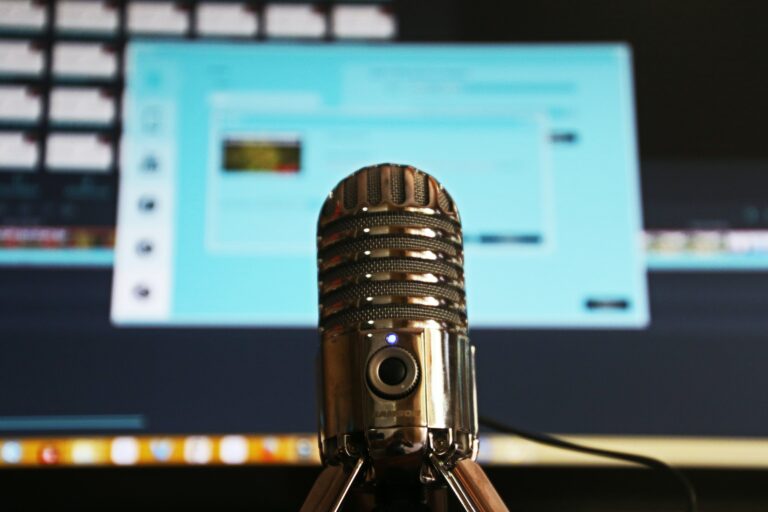Using the right Podcasting microphone is important if you care about your audience. A great podcasting microphone ensures you have clean sound with limited background noise. Having a great microphone will also save you time and money when it comes to editing your podcast.
In this article, we will share 3 podcasting microphones to improve your audio game.
And a quick crash course on how to pick the best podcasting microphone for your podcasting needs.
There’s a lot of debate about which microphone is the best podcasting microphone. As you probably know, there are a few different types of microphones.
The three most popular podcasting microphones are:
- condenser microphones (which belong to the “prosumer” category)
- dynamic microphones (which are small tube-shaped microphones and belong to the “consumer” category)
- ribbon microphones (which are based on ribbon cables and belong to the “professional” category).
The difference between pro and consumer/consumer-level microphones or between ribbon and dynamic ones is primarily in their price. The absolute cheapest one is going to be a dynamic mic, while the most expensive one will be either a ribbon or a condenser mic.
If you have money, then you can either pay extra money for high-quality dynamic mics; but if you don’t have any money at all and only want good sound quality for your podcast, then a dynamic mic will do just fine.
Podcasting microphones for Beginners
So, here are three microphones we think are ideal for beginners who want to start creating a great-sounding podcast:
- The first microphone is also a recorder — it’s the Zoom H6. It’s got a very wide dynamic range, so you can deliver both high and low end of your audio with very little distortion. What’s more, it has noise-cancelling technology which means that when you play back your recordings in loud rooms or on public transport, no sound will ever leak out of the microphone or give anyone the wrong impression about your voice. The podcasting microphone also has a built-in headphone socket so you can use it in a quiet environment without worrying about disturbing others around you. Plus it comes with an adapter cable so that you can plug directly into your computer instead of having to use an external adapter (which adds weight and also takes up extra space).
- The second is the Rode NT-USB Studio Condenser USB Microphone. This mic stands up to nearly any kind of use and gives improved sound quality than its predecessor. It has a pop filter and has a USB input so it plugs straight into your computer.
- The third option is the Audio Technica: The AT2020. It stands at just 8cm tall and weighs only 17g (almost half as much as an iPhone!) The AT2020 is a USB condenser microphone, but if you want to plug it into a recorder, then you might consider the AT2040 – just depends on the podcast setup you are building.
Best Recording Mics for Podcasting
This is something we blogged on in an earlier post.
When it comes to audio recording, there are a few things that every video maker should know:
1. The microphone you use has to have good sound quality.
2. The microphone you use has to have a good frequency response (i.e., it needs to be able to pick out the range of frequencies in the recording).
3. The microphone needs to be stable and reliable so that it doesn’t move up and down as you speak or as the camera moves around during shooting
4. The tripod needs to be sturdy enough so that your mic can stay stable when you move around (this is also called “headshake”).
5. You need a small, lightweight, comfortable microphone that you can carry around with you everywhere so that you don’t always have to hold one device in your hand while doing shooting (also called “heftiness” or “chaffiness”).
While each of these points is important, they are only worthy if they are all met and even then they are not equal. If any of these things aren’t met and if you provide bad audio on your podcast, people will associate it with bad audio quality and may not bother listening to the rest of your podcast again or watching your videos on YouTube again for that matter. And once people start associating bad audio quality with your podcasting capability, there is no going back.
What makes the three listed microphones above so special? They meet all the previous criteria above: they deliver excellent audio quality at a nice price point; they don’t require fancy recording gear; they are small enough for carrying around; they are easy to use; and most importantly, they are very reliable at their job — which makes them perfect for beginners or anyone who wants to improve their audio game but doesn’t want to spend big money on fancy recording gear yet has limited money available for investing in good equipment.
So now that you have some background, if you don’t want to buy one of the suggested microphones above, then ask yourself these questions:
- What kind of microphone do I want for my podcast?
- How much money do I want to spend on it?
- What kind of microphone do I need for my project?
There are many other microphones on the market today that offer good sound quality in terms of both clarity and low noise level. Others have better features than the ones mentioned above and we’ve shared a list that should get you started. There are many microphones out there that let us make great sounds in our podcasts, but it’s all about finding the balance between quality, price and your usage needs. Don’t forget that no matter how good your microphone is, you should always be recording in a quiet space with lots of carpet and not too much ambient sound.
Already have a podcast? Want to create quick audiograms through your RSS feed now your microphone game is cutting edge? Check out how Sonnant can help improve your audio game.




